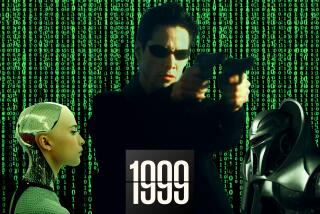Jaron Lanier: Loss of the virtual dream
Despite the binary nature of his own neural wiring, each synapse an on/off switch, passing electrochemical messages from axon to dendrite, Jaron Lanier will be the first to tell you that the mind is not a digital device. We are analog creatures, staticky and mysterious, resistant to the normalizing containment of code. Lanier’s mind has few apparent boundaries. It grapples with zombies and “gray goo,” “inner trolls” and the “lords of the computing clouds,” with “cephalopod envy” and “songles” -- “A songle is a dongle for a song,” Lanier explains, in case you didn’t know -- with “the mystery of Bengalese finch musicality” and the bucket containing all red things.
Lanier is a computer programmer, though you might not guess it to glance at him. He is bearded and dreadlocked and would not look out of place strumming an oud on Berkeley’s Telegraph Avenue. He does, in fact, live in Berkeley and plays the oud, among many other obscure acoustic instruments; he has collected more than 1,000, he says. And once upon a time, back when the letter “e” was just an innocent vowel and the World Wide Web was a Napoleonic spider’s dream, Lanier busked on the sidewalks of Santa Cruz.
That was before he became one of the inventors of the strangely immaterial world he named “virtual reality,” before he became an early-boom-time Internet guru who later morphed into a soft-voiced tech-world Jeremiah, warning in multiple manifestoes of the dangers of the hive mind, of “digital Maoism” and “cybernetic totalism.”
Lanier, 49, has just published “You Are Not a Gadget: A Manifesto” (Alfred A. Knopf: 212 pp., $24.95), his first book. He is an interdisciplinary scholar-in-residence at UC Berkeley and has what he calls “an evolving relationship” with Microsoft about which he only cares to say, “I’m trying to help them make stuff.” For all his accomplishment, he had little formal education. He grew up in rural New Mexico to bohemian parents and in the late 1970s fell in with the community of mathematicians, physicists and computer scientists at New Mexico State University, near the White Sands missile range. By the time he left home in his late teens, he says, “I had unusually advanced computer skills for a young person.”
He is being modest. Lanier drifted to Silicon Valley and, with funds earned from a now-forgotten video game called Moondust, set up shop in “the proverbial Palo Alto garage.” There, with a few friends -- some of whom went on to design the Macintosh -- he created the first immersive experience in virtual reality. His original notion was to develop “something that would take the extreme possibilities of internal experience and bring them into a realm where they’re shared with people instead of being sources of isolation.”
Once-limitless optimism
If that sounds like a pretty good definition of art, it’s not accidental. At the bottom of Lanier’s cyber-tinkering is a fundamentally humanist faith in technology, a belief that wisely designed machines can bring us closer together by expanding the possibilities of creative self-expression.
A similar species of limitless optimism animated the early days of the Web. It’s hard to imagine now, but at the dawn of the Internet era, Lanier writes, “I eagerly anticipated a chance . . . to be thrust into lush aesthetic wildernesses, and to wake up every morning to a world that was richer in every detail because my mind had been energized by unforeseeable art.” Yes, he’s talking about the World Wide Web.
For the first few years, Lanier argues, the Net lived up to that potential. Individuals created free-form home pages, posting poems, theories, rants, pictures of their cats and, importantly, links to the pages of like-minded kooks. Lonely eccentricities quickly spawned communities. People behaved not as passive consumers but as active creators of their own culture. It was, Lanier says, “what we’d all hoped and dreamed of.”
Then the money arrived. “Voluntary productivity had to be commoditized,” Lanier writes. But the problem wasn’t just commercialization -- it was commercialization of a particular sort, in line with a particular view of the relationship between humans and computers. In December 2000, Lanier published a lengthy manifesto in Wired magazine attacking what he called “cybernetic totalism,” the nerd creed that favored computation over human experience.
Preserving the immeasurable weirdness of human creativity was of no interest to most people writing code. Human beings were of no interest. Cybernetic totalism, as Lanier described it, has its own apocalyptic vision: “The Singularity,” a Matrix-like future in which machines win supremacy over humans. For the nerd faithful, this is a desirable outcome. More likely, given the bugginess of human-written software, Lanier cracked, was a “Planet of Help Desks.”
In 2006, Lanier published another widely read manifesto, this time attacking the “digital Maoism” that he saw exemplified in Wikipedia’s “fallacy of the infallible collective.” While the digerati sang the praises of the emerging “hive mind,” Lanier saw another effort to erase all individualism -- and liberatory potential -- from the Web. “The hive mind is for the most part stupid and boring,” Lanier wrote. “Why pay attention to it?”
“You Are Not a Gadget” extends that analysis, adding thoughts and observations -- many culled from his column in Discover magazine -- on everything from Stravinsky to giant Australian cuttlefish. The problems spawned by anti-humanist software design, Lanier argues, don’t stay online: “It is impossible to work in information technology without also engaging in social engineering.” Facebook, he writes, confines creativity to preestablished fields, reducing our oceanic complexities to “multiple-choice identities” that can be sold to marketing databases. Cyber-reductionism, Lanier has it, actually shrinks us.
This can get a bit curmudgeonly; most writers I know use Facebook, but few have limited their creative output to status reports about their latest snack. Lanier’s basic insight, though -- that technology shapes us as much as we shape it, and that nothing about its design is predestined -- is important. He has played a role in enough of the major tech innovations of the last three decades to know precisely how contingent the current cyber-landscape is.
Take MIDI: Casually designed by a colleague of Lanier’s as an expedient way to represent musical notes on a keyboard synthesizer, it ended up becoming “the standard scheme to represent music in software” -- not because it was the best but because it was there and easy to build on. In the process, MIDI changed the way music sounds for all of us. Lanier’s worry is that “people are becoming like MIDI notes -- overly defined, and restricted in practice to what can be represented in a computer.”
Commodity futures
Lanier is at his sharpest when he sticks to this level of detail. His broader cultural critiques too often fall into a techno-reductionism that understands all phenomena as side effects of innovation. It is difficult, for instance, to explain the commercialization of the Web without acknowledging the world beyond it, in this case, capitalism’s tendency to transform everything, no matter how immaterial, into a commodity. But Lanier politely resists attempts to nudge him into criticizing the market and explains the collapse of his Internet Eden entirely in the context of programming decisions: “The rules were rewritten by geeks who didn’t value human expression.”
Similarly, Lanier scorns pop-cultural retro-fads and worries that the online availability of predigested fragments of “content” has killed originality, inaugurating the age of the permanent mash-up. “It’s as if culture froze just before it became digitally open,” Lanier writes, “and all we can do now is mine the past like salvagers picking over a garbage dump.”
But culture hasn’t frozen; Retro occupies just a thin, white sliver of the pop spectrum. And sampling, which spawned the late 20th century’s one original musical genre -- hip-hop -- pre-dates the Web by more than a decade. In the 1980s, mashing was called mixing, and it was a distinctly analog good time.
Still, Lanier can be forgiven the occasional spell of stodginess: Did you invent virtual reality? His mind is a fascinating place to hang out. And if the aristogeeks are anywhere near as crazy as he says they are -- “gray goo,” by the by, refers to the skein of microscopic nanobots that will eat the Earth when the machines take over -- we need all the help we can get.
Ehrenreich is the author of the novel “The Suitors” and a fellow of the Horizon Institute.
More to Read
The biggest entertainment stories
Get our big stories about Hollywood, film, television, music, arts, culture and more right in your inbox as soon as they publish.
You may occasionally receive promotional content from the Los Angeles Times.






